Genre: Self Help | Productivity
Length: 319 pages
Publish Date: First published October 16, 2018
Have you ever thought that in a competition every participant has a common goal but the winner is one. Why?
In the long run we all run after a golden opportunity or desired goal, but many of us remain behind due to the lack of good habit formation. Good habit formation is kind of a little war against our mind or comfort zone. Most of us think of becoming better from the first day but then become tired of the process.
Our daily decisions are ultimately made by the tiny, consistent acts we take, which ultimately shape the course of our lives. Over time, we can achieve major advances if we concentrate on forming positive habits and kicking negative ones. Even 1% betterment of habits everyday can count for a lot in the long run as habits can be considered as the compound interest of self-improvement. Habit can also be defined as a double edged sword, which can have the potential to either benefit or hinder your efforts.
According to Clear, the winner and the loser have the same goal so to gain a better result, one should focus on the system instead of the goals.
The Fundamental of Atomic Habit
Have you ever thought of why it is so easy to repeat bad habits rather than forming good ones?
Enhancing your daily routine can have a big impact on your life. However, once your habits are established, they can persist, especially unwanted ones.
There are three layers of behaviour change:
- Change in outcomes: this level is concerned with change in your results, for example losing weight, winning championship. Most of the goals we set are associated with this level of change.
- Change in process: this level is concerned with change in your habits and systems, for example implementing a new routine at the gym, developing a meditation practice. Most of the goals we build are associated with this level of change.
- Change in identity: this level is concerned with change in your beliefs, for example judgement about ours and others. Most of the beliefs, assumptions we hold are associated with this level of change.
Many people begin the process of changing their habits by focusing on what they want to achieve which leads to outcome-based habits , whereas, many begin by focusing on who they wish to become which leads to identity-based habits.
Habits are formed through The process of ” Habit formation loop” which consists of a cue, a routine, and a reward. The Cue is the signal that prompts to take action, the Routine is the action itself and the Reward that maintains the persistence of behaviour. By understanding and manipulating this loop, more effective habits can be created and maintained.
The Four Laws of Behavior Change
The ultimate purpose of habits is to solve the problems of life with as little energy and effort as possible. The process of building a new habit can be divided into four simple steps:
Cue: triggers your brain to initiate a behaviour
Craving: motivational force behind every habit
Response: the actual habit you perform
Reward: the end goal of every habit
Every habit is based on this four-step pattern, the first two steps are called ‘Problem phase’ and the last two steps are called ‘Solution phase’, which the brain repeats automatically.
According to James Clear, the four stages of behaviour change can influence nearly everything we perform each day. To understand how the four laws of behaviour change works, we need to transform these laws into a practical framework that we can use to design good habits and eliminate bad ones.
Good Habit Formation
The 1st law (Cue) : make it obvious
The 2nd law (Craving) : make it attractive
The 3rd law (Response) : make it easy
The 4th law (Reward) : make it satisfying
Destruction Of Bad Habit
Inversion of the 1st law (Cue) : make it invisible
Inversion of the 2nd law (Craving) : make it unattractive
Inversion of the 3rd law (Response) : make it difficult
Inversion of the 4th law (Reward) : make it unsatisfying
Let’s talk about “The Four Laws of Behavior Change”:
First Law of Behaviour Change: Make it Obvious
Studies show that habits cause our minds to light up, and the goal is to choose a clear cue that consistently starts a habit. According to the law, one should set a new goal to an existing one, exploiting Habit Stacking. For example, After working out, I will take my detox water before I jump into work. Again to maintain good habits, favourable environment setup should be done. For example, to drink more water, leave water bottles around you in your home or office.
Second Law of Behaviour Change: Make it Attractive
To Make a new habit appealing, it’s important to develop a craving that will encourage you to practise a new habit. According to the law, Temptation Bundling works in favour of new habit formation. For example, if you are fond of book reading or watching movies,then you promise it to yourself after maintaining a good habit. The Method of Temptation Bundling is similar to Habit Stacking which puts a constant encouragement on you.
Third Law of Behaviour Change: Make it Easy
Motivation is often considered as the primary factor in facilitating habit change, whereas humans are wired about conserving energy. For example, if you want to maintain any diet chart then it will be easier for you to maintain it if you chop & store your required fruits and vegetables in containers in your fridge, as it conserves your time & energy. Again if you want to decrease your screen time then keep your device away from you or shut it down or to make it worse turn off the Wi-Fi or internet connections.
Again, according to Covey, the use of TWO-MINUTE RULE motivates you to start your habits on a small scale. For example, it’s hard to start a 30 minutes workout from the first day but you can start small by doing just 5 minutes and increasing it by 2 minutes each day.
Fourth Law of Behaviour Change: Make it Satisfying
According to the study, human behaviour is derived by the desire for instant gratification. Good habits, however, frequently pay off slowly, so it will be beneficial if you can immediately feel the benefits of your behaviour. For example, if you want to develop a 30-second hand washing habit to stay safe then offer yourself an immediate satisfaction by buying nice smelling, extra foamy soap to make the experience pleasurable. Again if you want to skip dessert then you can set aside a piggy bank to save some money for a desired trip each time you skip it. Additionally a Habit Tracker can help you in not breaking the chain of habits maintained by recording your progress simultaneously.
Success is not a goal to reach or a finish line to cross rather it’s a never ending process or system of improvement and refinement. So, we should focus on the path and the result will come itself.











